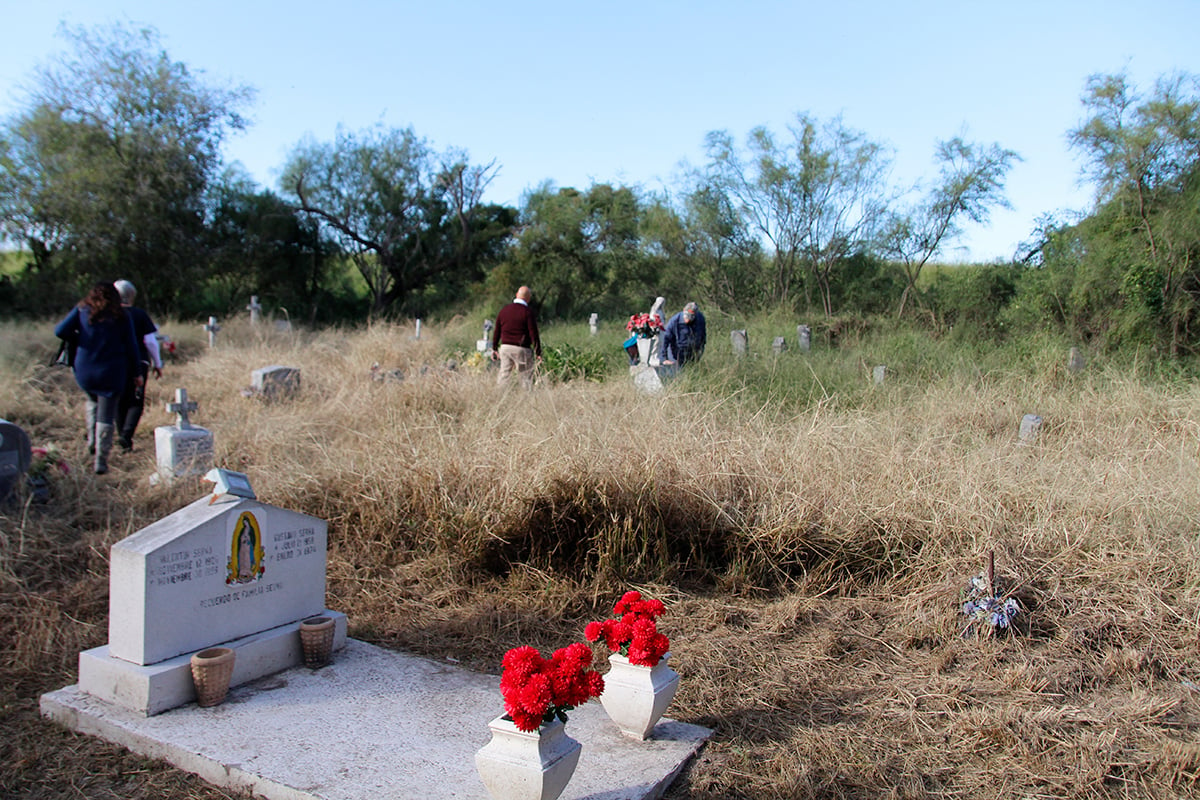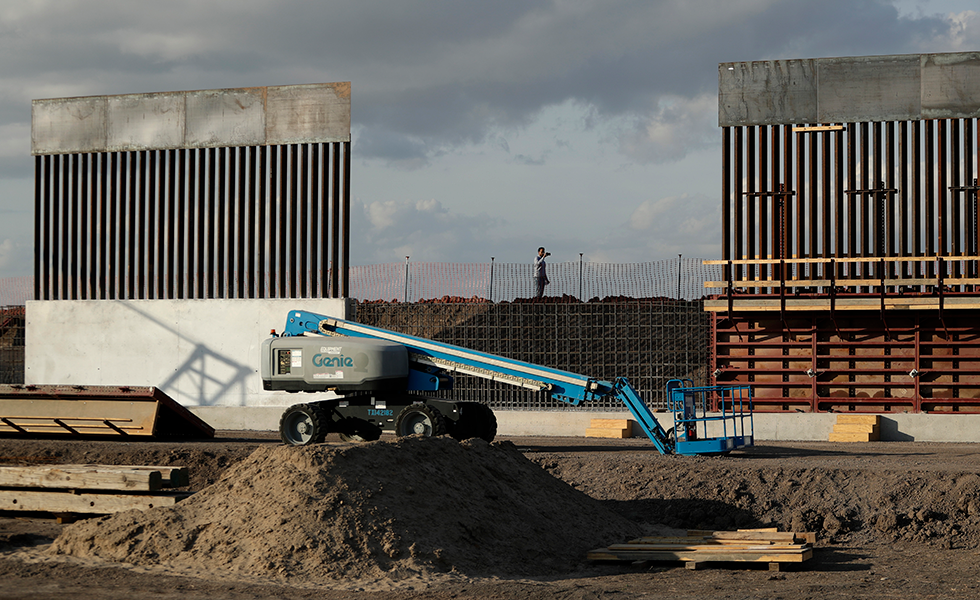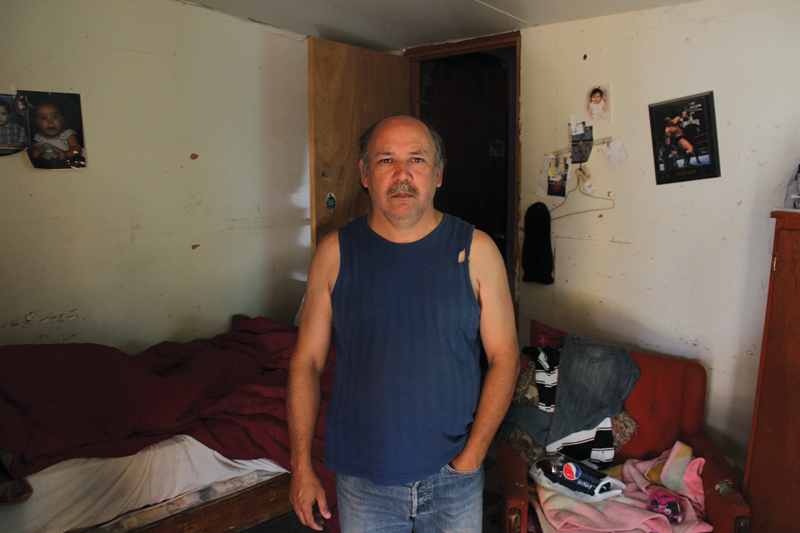
Postcards: Life In a Colonia Called ‘The Ranch’

Above: Baldemar Flores, 49, stands in the living room of his house in Cuevitas. His home lacks running water and has holes in its roof.
The first thing you notice about Cuevitas is the smell: an aroma of smoke and ash left over from trash that may have been burned the day before, but lingering on the warm Texas air. The next thing is the houses, some brick, some wooden, most of them single-story shacks with peeling paintwork. A few look uninhabitable, but even these show signs of life: washing hung on a strand of frayed rope strung between trees, fresh tire tracks in the dirt.
Even the most dilapidated of these homes have trees and shrubs planted in their dusty yards, or cacti in pots, watered and tended, sources of apparent pride in this neighborhood that has little of anything else.
This is Cuevitas, 266 miles due south of San Antonio, 30 miles west of McAllen. On a map it looks like a suburb of tiny Sullivan City, but once you’re here it feels remote, cut off from anywhere. Locals call it “The Ranch.” It’s a close-knit community of about 40 souls and 15 houses, many of them home to the same families for generations. Cuevitas is considered the poorest town in Texas.
You get to Cuevitas via Military Road, and the only vehicles that use that thoroughfare regularly, aside from those owned by the people who live here, belong to Border Patrol. As the crow flies, Cuevitas is just half a mile from Mexico.
It’s also one of several thousand colonias in South Texas—impoverished communities where many people live without proper sanitation, electricity or running water. According to the Texas Secretary of State, colonias date to the 1950s, when developers began creating unincorporated subdivisions on agriculturally worthless land that lay in floodplains. The agency’s website says such developers divided that land into small plots, installed little or no infrastructure, then sold the plots to low-income buyers, usually at vastly inflated interest rates. An estimated 400,000 Texans live in such colonias.
Baldemar Flores, a 49-year-old resident of Cuevitas, lives with his son, mother, sister, niece and nephew in two houses that share an acre of land—the last plot on Military Road before it turns into Old Military Road and disappears west along a route the first European settlers would have crossed in the mid-1700s.
If you kept walking for about nine miles (you can’t drive; the road is impassible in places), you’d come to La Grulla, a city of about 1,500, where Baldemar’s mother was born. His dad was born in Cuevitas in 1925, in the house just over the fence from the one Baldemar lives in now. Back then there were more houses here. There was even a grocery store and a little school, the one his father attended, built on a hill with views across the Rio Grande Valley and into Mexico. It’s different now, fewer people. Many have moved to McAllen in search of jobs.
Baldemar emerges from behind a piece of construction fabric pinned up to cover the gap where the front door of his house should be. He squints at the sun as he steps outside onto the rocky driveway wearing jeans and a tank-top with a hole in the shoulder. “People got tired of The Ranch,” Baldemar says, looking off into the distance. “Life is tough.”
He used to work as a bus driver in La Joya, just a few miles east, but now he picks up occasional shifts driving trucks locally. The most recent available census data shows the average annual income here is just $1,700, but that reflects information collected more than a decade ago. Census statistics from 2010 are blank for Cuevitas, as if it has been forgotten. Regardless, the McAllen-Edinburg-Mission area, of which Cuevitas is a part, is the poorest of all metropolitan areas with populations over 50,000 in the U.S., with 37.7 percent of households living below the poverty line. (Fresno, California, is second.)
McAllen city buses service Cuevitas on Mondays, Wednesdays and Fridays. They turn around at the end of Military Road, just outside Baldemar’s property, right by the little fence where, six months ago, he says he saw some 50 Mexicans hiding after crossing the border illegally. “Border Patrol didn’t see them,” he tells me, laughing. “Or they didn’t want to see them because there is too much work processing the paperwork.” Baldemar says he frequently hears gunfire in the rural communities on the Mexico side.
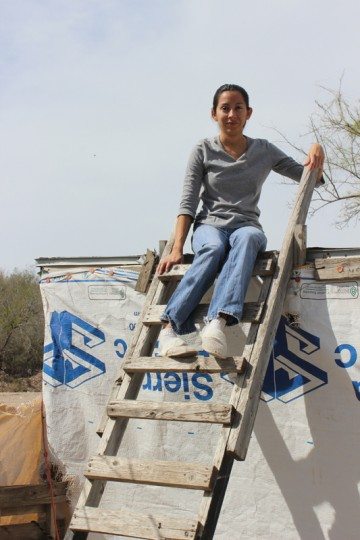
Once a week his sister, Maria, and her 23-year-old daughter, Melissa, travel into Sullivan City to pick up what few groceries they can afford with what little money they have. Baldemar’s mother, Guadalupe, matriarch of the Flores clan, makes tortillas and cooks rice, beans and eggs for the family. They used to grow some of their own food, until the opossums discovered the vegetable garden.
Baldemar gives me a tour of his house. A red armchair, split and oozing fibers, occupies the center of the living room. The walls are scuffed and peeling. The kitchen is unusable: wooden cabinets are falling off the wall, blue sky shows through a hole in the roof, and there’s water damage everywhere. “The roof is messed up,” Baldemar says, “and there’s no insulation. It gets cold.” When it rains—and Baldemar prays that it doesn’t—the kitchen, dining room and bedroom flood. His single A/C unit works, he says, but it “sounds like an 18-wheeler.”
The entire house slopes to one side—the result of subsidence. The plumbing hasn’t been connected for some time now, ever since the water company wrote to tell Baldemar that only one of the property’s two houses could be connected to a meter. “I take baths at Mom’s house and go there to make coffee or whatever,” he says.
In the bedroom that adjoins the living room, Baldemar’s 21-year-old son, Michael, is asleep. He has ADHD and arthritis, and doesn’t get up until midday, when the sun warms up. Stuck to the wall are pictures of Baldemar’s four children as babies. Jorge-Luiz, 20; Giovanni Emmanuel, 15; and Valerie Alexis, 14, live with their mother; the two are no longer married.
Baldemar tells me Michael receives no Social Security benefits or Medicaid and that this is a result of his mother refusing to show bank statements to the proper authorities. But Michael is 21 now, an adult who could apply for benefits without parental help.
I’ve come to Cuevitas with Mando Garza and Saul Villareal of Proyecto Azteca, an organization set up in the early 1990s by the United Farm Workers of America, Texas Rural Legal Aid, and the Texas Low Income Housing Information Service to respond to the housing crisis represented by the colonias of Hidalgo County.
In addition to his role as policy coordinator with Proyecto Azteca, Garza also happens to be the mayor pro tem of San Juan, just outside of McAllen, and I leave him and Villareal to speak with Baldemar about the possibility of assisting with a renovation or, as he’ll most likely need, a new home altogether. Proyecto Azteca is a self-help program. Families are required to put in 550 sweat-equity hours, helping build or renovate their homes. The organization then offers a 0 percent interest mortgage and access to a tool library from which homeowners can check out equipment. Proyecto Azteca currently has 2,800 families like Baldemar’s on its waiting list, each desperate for a new home, or repairs to the one they already inhabit.
Baldemar’s niece, Melissa, was born in Mission but grew up in Cuevitas. She graduated from high school but says she can’t find a job due to a learning disability and anxiety that has plagued her since her uncle, Abel Flores Jr., died of cancer three years ago. “I was really close to him. He’d pick me up and take me to his house every Friday.”
Melissa says her family survives largely on her grandmother’s $80 Social Security check, but she says they love it here. “It’s quiet,” she says. “In the evenings we make a fire outside and take our coffee or hot chocolate out there.”
She leads me around the side of the house, past the bougainvillea blooming in front and past the construction fabric fixed to one side of her grandmother’s porch. Melissa’s two pit bulls poke their faces through a hole in the fabric to see what’s going on. She shows me the ladder she likes to climb when the sun goes down so she can sit on the roof of the rickety carport and watch the world go by.
In the last couple of days, the local phone company has installed an underground cable to connect the Flores house so Melissa can have Internet access. A mound of disrupted earth snakes from the front gate as if a cartoon mole has burrowed its way into their lives. “I want to get into an online college,” Melissa tells me. “I want to become a vet.”
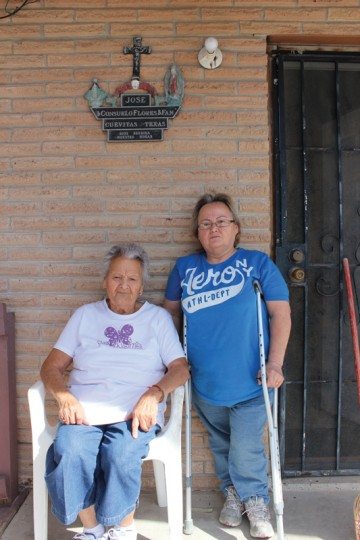
Consuelo Flores—no relation to Baldemar—lives just up the curbless, paved street, which is framed by cedar and mesquite. Consuelo was born in Sinaloa, Mexico, in 1936, and came here at 17, when she got married. Today she lives in a modest brick house that’s connected to electricity, water and—recently—the city sewer.
It wasn’t always this way.
When she first arrived, she lived in a much smaller home that her in-laws built. Extension cords delivered electricity from the neighboring property, and the family collected water in barrels. “We had a kitchen and two little additions,” she tells me in Spanish translated by her daughter, Sanjuanita Dominguez. “I had eight children in that house—the first was born in 1954, and they were a year apart.”
Consuelo sits on her sofa, staring ahead at the open front door. Pictures of her family dominate the walls of her little living room, and a small statue of Christ looks out from a wooden cross on the wall behind the door. Consuelo gave birth to 10 children, but two died, her daughter tells me.
Back then there were no food stamps, and the Floreses survived on $4 a day that Consuelo’s husband made working in the nearby fields. “Mom would make delicious homemade tortillas,” Sanjuanita says. “We’d make a fire outside then bring the hot coals inside the house to do the cooking and to use as a heater.”
Consuela shakes her head. “There are no disadvantages to living here,” she says. “I was raised here.”
“This is all she knows,” Sanjuanita says.
In San Juan, east of McAllen, I meet Ann Cass, the executive director of Proyecto Azteca. Ann moved to Texas from Atlanta 33 years ago and worked initially as an administrator for United Farm Workers of America. She joined Proyecto in 2006.
Ann likes to say that if she had the cash it would take to build just one mile of the border fence—about $12.5 million—she could assist every colonia-dweller who asks for help.
Mostly, though, they need jobs.
“They’re a viable workforce. Bilingual. Young. But they’re caught between a rock and a hard place,” she says. “No factory will relocate next to a colonia because there is no drainage and there’s a lack of streetlights.”
Because many neighborhoods are dark at night, there’s also a lot of crime. “It takes forever for the sheriff’s department to arrive,” she says. That’s if they get there at all. Because many of these developments are unincorporated and ad hoc, addresses are changeable and inconsistent. Fire trucks and police often can’t find the homes they’re sent to.
Ann says it would benefit the children of such colonias to participate in after-school activities: fine arts, drama, all the things, she says, that we know help to improve kids’ behavior and employability. But many families don’t have cars, and school buses don’t provide evening transport.
And don’t get Ann started on health care. There is no public hospital in McAllen, and 44 percent of Hidalgo County residents either have no insurance or are underinsured. Sixty-one percent of children in colonias are morbidly obese, Ann says. “They sit in front of the TV. The grocery stores sell junk food. There are no sidewalks to shoot hoops.”
There are projects designed to address these problems. One such, out of Texas A&M University, offers Hidalgo County mothers and children health-education programs. Another offers free transport to fruit and vegetable markets.
In 1989, the Texas Legislature passed a bill requiring developers to install basic infrastructure and utilities in all future colonia developments. Six years later, legislators passed a bill authorizing counties to provide water and sewage services.
But Ann says those rules are now under threat, that there’s a united effort among South Texas developers to do away with them as too expensive. She finds the complaint troubling. “If they can’t afford to build, they shouldn’t be building,” she says.
While South Texas developers have begun installing infrastructure in colonias, they often sell the plots at exorbitant interest rates of 22 to 28 percent. Families buy plots that have water and electricity but then can’t afford to build proper homes on them. Instead, they build sub-standard houses out of stuff from the hardware store or found materials. The result, Ann says, is effectively a colonia, but according to the state it’s a “model subdivision.”
“The state will tell you there are 1,200 colonias in Hidalgo County, but how do you define a colonia?” she asks. “These places are prone to electrical fires, the people there suffer respiratory problems, there’s no insulation. And they’re not built to withstand the weather events we have here. We’ve had two hurricanes and two tropical storms within the last five years, and they’re traditionally built in the delta and so are prone to flooding. The Rio Grande Valley isn’t a valley at all,” Ann points out. “It’s a delta. A floodplain.”
Jim Harrington, founder and director of the Texas Civil Rights Project, which he established in 1990 to promote racial, social, and economic justice through litigation, education, and social services, tells me the residents of Texas’ colonias aren’t getting enough help.
“There has been some state money, grants to nonprofits [like Proyecto Azteca, which operates on a mix of state, federal and county funding], but not very much,” Harrington says. “Colonias are so dependent on outside money, church groups, that kind of thing. It’s pretty sad. You’d think after all these years there would be change. But there’s no real commitment by the Legislature. These are minority areas, largely Hispanic, and therefore Democratic, so there’s no political motivation on behalf of the Republicans to do anything.”
Back in Cuevitas, Baldemar is getting ready to tend the little garden his father built, fenced off at the front of the property, adjacent to the road. There are orange trees, a little dirt path winding its way through the sage and bougainvillea, a wooden bench, and some rose bushes beyond. “We try to water it every other day,” Baldemar says.
Baldemar’s father died five years ago. The garden was his pride and joy, a little oasis in the dusty expanse of The Ranch. Chicana writer Gloria Anzaldua once wrote that, in poverty-stricken South Texas, everyone grows flowers. “If they don’t have a piece of dirt, they use car tires, jars, cans, shoeboxes,” she said.
So it is in Cuevitas. The vibrant pink bougainvillea, the purple sage, they bring color to the poorest place in the state. A place that Baldemar and his family have no intention of ever leaving.
